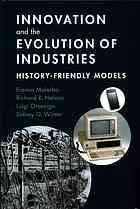
Innovation and the evolution of industries : History-friendly models PDF
Preview Innovation and the evolution of industries : History-friendly models
Innovation and the Evolution of Industries The revolutionary impact of technological innovation on the dynamics ofindustrial structures hasbeen one ofthe distinguishing features of modern capitalism. In this book, four leading figures in thefieldofSchumpeterianandevolutionaryeconomictheorydrawon decades of research to offer a new, “history-friendly” perspective on the process of creative destruction and industrial change. This “history-friendly” methodology models the complex dynamics of innovation, competition and industrial evolution in a way that combines analytical rigor with an acknowledgment of the crucial role of history. The book presents a comprehensive analysis of the determinantsandpatternsofindustrialevolutionandinvestigatesits complex dynamics within three key industries: computers, semiconductors and pharmaceuticals. It will be of great value to scholars and students of innovation and industrial change, from backgrounds as varied as economics, management, history and political science. Its coverage of new methodological tools is also usefulforstudentswhoarenewtoevolutionaryeconomictheory. franco malerba is Professor of Applied Economics at Bocconi University in Milan and President of ICRIOS. He is the former president of the International Schumpeter Society and of EARIE (EuropeanAssociationofResearchinIndustrialEconomics).Heisan EditorofthejournalIndustrialandCorporateChangeandauthorofa large number of articles and several books on industrial economics, innovationandthedynamicsandevolutionofsectors. richard r. nelson is George Blumenthal Emeritus Professor of International and Public Affairs, Business and Law at Columbia University, and heads the program on Science, Technology, and GlobalDevelopmentattheColumbiaEarthInstitute.Heisaseminal figure in evolutionary economics and is the coauthor of An EvolutionaryTheoryofEconomicChangewithSidneyWinter. luigiorsenigoisProfessorofAppliedEconomicsatIUSS(Schoolof AdvancedStudies),Pavia.HeiscoeditoroftheJournalofEvolutionary Economics, theauthor ofseveral books, andmore than 100 publica- tionsinmajorinternationaljournals. sidney g. winter istheDeloitteandToucheEmeritusProfessorof Management at the Wharton School, University of Pennsylvania. With Richard Nelson, he coauthored the highly cited book An EvolutionaryTheoryofEconomicChange.Hewasthewinnerofthe ViipuriPrizeinStrategicManagementin2008andtheGlobalAward forEntrepreneurshipResearchin2015. Innovation and the Evolution of Industries History-Friendly Models franco malerba BocconiUniversity richard r. nelson ColumbiaUniversity luigi orsenigo IUSS,Pavia sidney g. winter TheWhartonSchool,UniversityofPennsylvania UniversityPrintingHouse,CambridgeCB28BS,UnitedKingdom CambridgeUniversityPressispartoftheUniversityofCambridge. ItfurtherstheUniversity’smissionbydisseminatingknowledgeinthepursuitof education,learningandresearchatthehighestinternationallevelsofexcellence. www.cambridge.org Informationonthistitle:www.cambridge.org/9781107641006 ©FrancoMalerba,RichardR.Nelson,LuigiOrsenigoandSidneyG.Winter2016 Thispublicationisincopyright.Subjecttostatutoryexception andtotheprovisionsofrelevantcollectivelicensingagreements, noreproductionofanypartmaytakeplacewithoutthewritten permissionofCambridgeUniversityPress. Firstpublished2016 PrintedintheUnitedKingdombyClays,StIvesplc AcataloguerecordforthispublicationisavailablefromtheBritishLibrary LibraryofCongressCataloging-in-PublicationData Malerba,Franco,1950–author. Innovationandtheevolutionofindustries:history-friendlymodels/Franco Malerba,RichardR.Nelson,LuigiOrsenigoandSidneyG.Winter. Cambridge,UK:CambridgeUniversityPress,2016.|Includesbibliographical referencesandindex. LCCN2016011386|ISBN9781107051706(hardback)|ISBN9781107641006 (paperback) LCSH:Industries–Technologicalinnovations.|Hightechnologyindustries.| Technologicalinnovations–Economicaspects. LCCHD2328.M352016|DDC338/.064–dc23 LCrecordavailableathttps://lccn.loc.gov/2016011386 ISBN978-1-107-05170-6Hardback ISBN978-1-107-64100-6Paperback Additionalresourcesforthispublicationatwww.cambridge.org/malerba CambridgeUniversityPresshasnoresponsibilityforthepersistenceoraccuracyof URLsforexternalorthird-partyinternetwebsitesreferredtointhispublication, anddoesnotguaranteethatanycontentonsuchwebsitesis,orwillremain, accurateorappropriate. Contents Listoffigures pagevi Listoftables ix Prefaceandacknowledgments xi Codes xvi Someremarksaboutnotation xvii 1 Innovationandindustrialevolution 1 2 History-friendlymodels:methodsandfundamentals 22 3 TheUScomputerindustryandthedynamicsof concentration 43 4 Verticalintegrationanddis-integrationinthecomputer industry 93 5 Thepharmaceuticalindustryandtheroleof demand 150 6 Repriseandconclusions 217 References 248 Authorindex 263 Subjectindex 264 v Figures 3.1 Attributesandtechnologicallimitsofcomputers withtransistorandmicroprocessor technologies page49 3.2 Preferencesandminimumthresholdsofattributes requirementsforthetwouserclasses 50 3.3 Simulationtime=30 69 3.4 Simulationtime=70 69 3.5 Simulationtime=130 70 3.6 HerfindahlinPCandmainframemarkets (StandardSet) 71 3.7 Numberoffirmsinmainframemarket (StandardSet) 72 3.8 NumberoffirmsinPCmarket(StandardSet) 73 3.9 MarketsharesinPCmarket(StandardSet) 73 3.10 Herfindahlindexinmainframemarketwithless importanceofbandwagonindemand 75 3.11 Shareoffirst-generation(TR)andsecond-generation (MP)firmsinmainframemarket 75 3.12 Herfindahlindexinmainframemarket:earlyentryof second-generation(MP)firmsandhighdifficultyof adoption 76 3.13 ShareofdiversifiedfirmsinPCmarket 78 4.1.a Herfindahlindex(StandardSet) 124 4.1.b Integrationratio(StandardSet) 124 4.1.c Averagenumberoffirms(StandardSet) 126 4.2.a Herfindahlindex(Noexternalmarketforsemiconductor firms) 128 4.2.b Integrationratio(Noexternalmarketforsemiconductor firms) 129 vi list of figures vii 4.3.a Herfindahlindex(Lowbandwagonformainframe firms) 130 4.3.b Integrationratio(Lowbandwagonformainframe firms) 131 4.4.a Herfindahlindex(Lowbandwagonforsemiconductor firms) 133 4.4.b Integrationratio(Lowbandwagonforsemiconductor firms) 133 4.5.a Herfindahlindex(Minordiscontinuity) 135 4.5.b Integrationratio(Minordiscontinuity) 135 5.1 Therapeuticclasses(TC)andmolecules 168 5.2 AverageHerfindahlindexinTCs 181 5.3 Herfindahlindexintheaggregatemarket 182 5.4 Numberofactivefirmsintheaggregatemarket, entryandexit 183 5.5 Numberofinnovativeandimitativeproducts 184 5.6 Shareoftotalprofitsderivingfrominnovative products 184 5.7 NumberofdiscoveredTCs 185 5.8 NumberoffirmsineachTC 186 5.9 Firmsizedistribution 187 5.10 Averagepriceofproducts 187 5.11a PatentdurationandaverageHerfindahlindex inTCs 189 5.11b PatentdurationandaggregateHerfindahlindex 190 5.12a Patentdurationandnumberofinnovativeproducts 191 5.12b Patentdurationandnumberofimitativeproducts 191 5.13a Patentdurationandprices,TPT=1 192 5.13b Patentdurationandprices,TPT=20 192 5.13c Patentdurationandprices,TPT=40 193 5.14a OpportunitiesandaverageHerfindahlindexin individualTCs 195 5.14b OpportunitiesandaggregateHerfindahlindex 195 viii list of figures 5.15a MarketfragmentationandaverageHerfindahlindex inTCs 200 5.15b MarketfragmentationandaggregateHerfindahl index 200 5.16 AggregateHerfindahlindexattheendofthesimulation indifferentfragmentationsettings 201 5.17a AverageHerfindahlindexinTCsunderalternative distributionsofthevalueofsubmarkets 202 5.17b AggregateHerfindahlindexunderalternative distributionsofthevalueofsubmarkets 202 Tables 5.1 Firstmoveradvantages page204 ix
